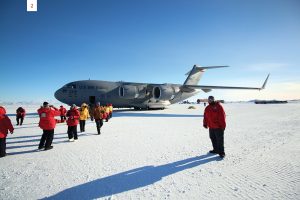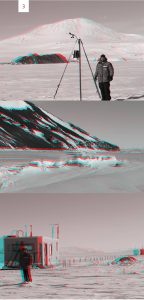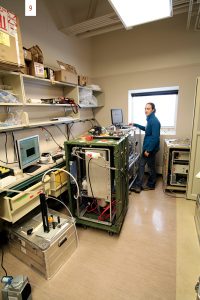Breathe. Feel the deep pinch of pure cold. With temperatures in Antarctica sometimes sinking to minus 110˚F, the southern continent can be as frigid as the surface of Mars. But that icy austral air has much to tell science.
In October, a team of scientists including a graduate student and a post-doctoral researcher led by Peter DeCarlo, an assistant professor in Drexel’s Department of Civil, Architectural and Environmental Engineering and the Department of Chemistry, traveled to Antarctica during the southern continent’s chilly summer season to amass one of the largest and most detailed datasets of the continent’s atmosphere ever assembled.
Among the 15 pieces of equipment they packed for the trip was a roughly 300-pound machine called an Aerodyne Aerosol Mass Spectrometer — a standard-setting device that DeCarlo helped to develop while a graduate student at the University of Colorado. The machine analyzes aerosols — tiny particles in the air, smaller than 1 micrometer each. Researchers have measured aerosol composition in Antarctica before, but never with a tool this fast and precise.
Thanks to a $390,000 grant from the National Science Foundation, DeCarlo became the first person to take the machine to the continent. The trip is the first of two planned with the device.
The information that the team collects could help scientists interpret ice cores to determine how Antarctica’s atmospheric conditions have changed over time.
“Antarctica is one of the remaining pretty pristine places on Earth, so we are interested in trying to understand changes in the natural cycle that may be caused by human activity,” DeCarlo says.
1. To reach Antarctica from Philadelphia — a 40-hour trip altogether — you first must get to New Zealand. The main passage to the continent is an unprepossessing terminal at the Christchurch International Airport. Through it flow researchers and support workers from around the world headed for McMurdo Station, the U.S. base in Antarctica that serves as the gateway to much of the continent. Before boarding, passengers are required to prepare for the 6.5-hour flight by suiting up in special cold-weather gear. Goggles, check. Balaclava, check. Your choice between mittens and gloves.
Flights to McMurdo are aboard massive Boeing C-17 military cargo planes contracted through Lockheed Martin by the National Science Foundation. Uniformed Air Force personnel serve as the cabin crew, and passengers ride inside a hold designed to haul cargo as large as Army tanks. Early in the season, seats are removed from the plane’s interior to make room for storage pallets filled with fresh food and supplies for the station. Later in the season, passengers outnumber cargo. On this particular flight, Drexel researchers were one of about 10 research teams heading to the station at the start of its spring/summer season to perform research projects that can only be done in the unique Antarctic environment.
2. Flights into and out of Antarctica are scheduled every two days, but sometimes entire weeks pass without a landing. Visibility vanishes perilously when wind picks up and blows snow across Pegasus Field, a year-round landing strip on top of an ice shelf about an hour from McMurdo Station. There’s a language to life at McMurdo that’s based on weather conditions. All travel is banned under “Condition 1.” Under “Condition 2,” travel off-base is restricted to enclosed vehicles. Under “Condition 3,” researchers are free to travel outdoors and flights continue as scheduled.
3. ![]() Air samples weren’t the team’s only souvenirs. They also took 3-D photos of Antarctica’s terrain. Sean Davis, a scientist with the National Oceanic and Atmospheric Administration, shot these using two ordinary DSLR cameras. To create the dimensional visual effects, the cameras were mounted side-by-side on a custom-made rail to ensure they were level with each other. Each camera was spaced a few inches apart and equipped with an automatic trigger. This technique produces two identical, but slightly offset (like our eyes) images which can then be tinted red and blue using free software and merged into one image.
Air samples weren’t the team’s only souvenirs. They also took 3-D photos of Antarctica’s terrain. Sean Davis, a scientist with the National Oceanic and Atmospheric Administration, shot these using two ordinary DSLR cameras. To create the dimensional visual effects, the cameras were mounted side-by-side on a custom-made rail to ensure they were level with each other. Each camera was spaced a few inches apart and equipped with an automatic trigger. This technique produces two identical, but slightly offset (like our eyes) images which can then be tinted red and blue using free software and merged into one image.
Visit exelmagazine.org to experience what it’s like to be in Antarctica through time-lapse videos and striking 3-D photographs.
4. McMurdo Station is like a small frontier town — remote and self-reliant. It boasts about 1,000 residents during the summer peak and a skeleton crew of about 250 who “winter over.” Researchers make up about a quarter of the population; the rest are mechanics, pilots, carpenters, cooks and other support staff. Owned by the United States and operated by the National Science Foundation, it is the largest of 30 research stations run by various governments on the continent, which is shared by international treaty. More than 100 permanent buildings have been erected at the station — a long way from the historic huts that mark the base’s first settlement and are still on the site — and they include medical buildings, a dining hall, firehouse, water distillation plant and power generator. Reputedly, some of the best evening views are from a dormitory lounge, where during the summer months the sun remains suspended above the horizon in a perpetual sunset.
5. Snowmobiles are the preferred mode of transportation in Antarctica. Lighter and faster than the large transporters known as PistenBullys, snowmobiles can cover in 30 minutes the same distance that takes a PistenBully two hours — perfect for scouting for a research base on the ice shelf of McMurdo Sound. Researchers chose a site about 19 miles from McMurdo Station, on top of six feet of sea ice over the seasonally frozen McMurdo Sound, which they selected because it’s a location where winds blow in both from land and sea. They marked their route out onto the ice with flags every 50 to 100 meters so that when visibility turned poor, they could find their way back to McMurdo.
6. A small fishing hut contained everything the Drexel team needed to conduct their research. Positioned on top of skis, the hut was hauled out onto the ice by large bulldozers and powered during the study by two diesel generators. Initially the team was worried that the instruments would get too cold, but in the end they had the opposite problem. Running constantly, the equipment sometimes heated the tiny space to 90˚F, forcing the team to install remotely controlled fans to cool down the interior. Antenna on the roof brought spotty Internet service via satellites, keeping the hut’s control panels connected to the team back at McMurdo Station, if only intermittently. From there, the team could monitor instrument readings as they poured in every few minutes, 24-hours a day, for five weeks.

7. The team’s small fishing hut contained about $1 million worth of sensitive air monitoring equipment.
A. The Aerosol Mass Spectrometer measures minute-by-minute changes in the chemical composition and size of particles in the air less than 1/100th the diameter of a hair. It is used by researchers all over the world as a powerful method for measuring submicron particle composition, size and concentration — but never before has the instrument been used in Antarctica. Most existing measurements of particle composition in Antarctica have been made using filter and impactor particle collection and off-line chemical analysis of samples. But these tools have limits. Filter collections and off-line analysis take a long time (days as opposed to minutes) to collect sufficient concentrations of particles, which can introduce sampling artifacts, and they have limited size distributions.
B. Filter collections (not visible in the photo) were used to verify that the spectrometer was getting correct readings.
C. Another device used for verification was the Scanning Electrical Mobility Sizer. It uses radioactive polonium to give particles a charge, which then enables the device to determine particle size distribution in the atmosphere from 20 nanometers to 1 micrometer.
D. This box contains an ultra-high sensitivity aerosol spectrometer that sizes particles optically
using lasers.
E. The Particle Into Liquid (PILS) Sampler is a prototype of a new design that was being used in extreme cold for the first time on this trip. It works by collecting particles into droplets that are stored in vials for later testing in a lab. This is the only instrument on the trip other than the filters that can be used to measure particle composition.
F. The gas phase instrument measures ozone (O3) and NOx (nitrogen dioxide, NO2, and nitrogen monoxide, NO) in the atmosphere. The team brought this along because when sun shines on snowpack at low wind speeds, the snow releases N0x through photolysis. The team detected a strong pattern of N0x increasing during daylight hours.
Additionally, the team recorded data on sun intensity, wind speed/direction, temperature, relative humidity and pressure.
8. Michael Giordano (pictured here with Lars Kalnajs, the project’s co-principal investigator and an atmospheric scientist at the University of Colorado) is a Drexel post-doc researcher whose previous experience with all 15 pieces of sampling equipment earned him an invitation to join the field campaign.
A native of the East Coast, Giordano was in the process of completing his PhD at the University of California – Riverside when this opportunity came up. “I kind of wanted to check off all seven continents and that last one is the hard one,” he says. “I was in the right place and the right time. It was serendipity, really.”
Before this trip, his only previous field campaign was on board a well-appointed, sparkling new cargo ship cruising up California’s coast. By comparison, living at McMurdo Station was like being in college, he says. “You live in dorms, have roommates, eat in a cafeteria, we even had basically RAs who made sure we did some cleaning for our floor.”
Once the thrill of being in one of the most remote ends of the Earth wears off, there is the job itself: 8- to 12-hour days consisting of rising, eating, suiting up in winter gear, traveling out to the hut, calibrating and checking equipment, and then traveling back, eating and sleeping.
The work could be tedious, Giordano admits. “But at some point you have to step back and say, ‘I’m out here standing on six feet of ice over water and I’m running a half-a-million-dollar machine,’ and that’s pretty cool.”
Back at Drexel, he’s now “slogging through” the many gigabytes of data collected. “We had some hypotheses when we went in and we’re seeing things to confirm what we thought and also things we didn’t expect,” he says. For example, the team observed some “depletion events” in which ozone dissipated under sunlight and particles were observed.
9. It takes special training to operate the Aerodyne spectrometer (partially visible under the laptop computer) — and experience is how graduate student Anita Johnson came to be part of the expedition. As an environmental engineering doctoral candidate, she has spent the two-and-a-half years of her education learning the machine’s ways. Before grad school, she had been fascinated by an Aerodyne spectrometer that belonged to a company where she worked, but she wasn’t allowed to touch it. She came to Drexel specifically to master it, and specifically to work with Peter DeCarlo. (The software that runs it actually has DeCarlo’s name on the copyright.)
Johnson grew up in California, and when she got the invite, she loaded up on several hundred dollars’ worth of outdoor clothing from Eastern Mountain Sports — “I hate the cold,” she says. But a chance to troubleshoot the machine on its maiden voyage in Antarctica? “I don’t think you pass on that,” she says.
Besides, it wasn’t as cold as she expected — most days were 15˚F to 20˚F and sunny. Inside the hut, where Johnson once spent the night amid the overheated equipment, it was practically tropical. “Sleeping out on the ice was one of the hottest nights of my life,” she laughs.











